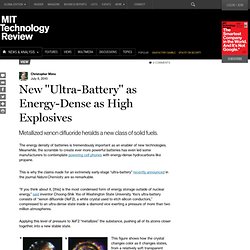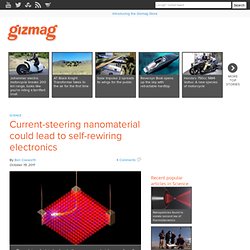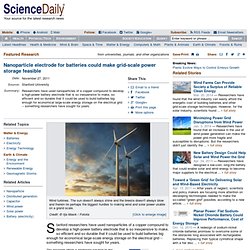

Practical Invisibility Cloaks. New "Ultra-Battery" as Energy-Dense as High Explosives. The energy density of batteries is tremendously important as an enabler of new technologies.

Meanwhile, the scramble to create ever more powerful batteries has even led some manufacturers to contemplate powering cell phones with energy-dense hydrocarbons like propane. This is why the claims made for an extremely early-stage “ultra-battery” recently announced in the journal Nature Chemistry are so remarkable. “If you think about it, [this] is the most condensed form of energy storage outside of nuclear energy,” said inventor Choong-Shik Yoo of Washington State University. Yoo’s ultra-battery consists of “xenon difluoride (XeF2), a white crystal used to etch silicon conductors,” compressed to an ultra-dense state inside a diamond vice exerting a pressure of more than two million atmospheres.
Applying this level of pressure to XeF2 “metallizes” the substance, pushing all of its atoms closer together, into a new stable state. The reaction would be, quite literally, explosive. Current-steering nanomaterial could lead to self-rewiring electronics. By applying electrical pulses to the new nanomaterial, a sea of small negatively charged ions (blue) can be pushed and pulled between larger, positively charged nanoparticles (red) which are 'jammed' in place (Image: Northwestern University) By now, we're all fairly used to electronic devices such as smartphones, which can act as a mobile phone, computer, camera and navigation unit all at once.

These devices, while multi-functional, still use different hard-wired electrical circuits for their different functions. Thanks to research being carried out at Chicago's Northwestern University, however, all those functions may one day be able to utilize the same physical piece of electronic material - the electrical current would simply be "steered" through it differently, depending on what was needed.
This means that a single section of the material could act as a resistor, rectifier, diode or transistor, as instructed by a computer. About the Author Post a CommentRelated Articles. Nanoparticle electrode for batteries could make grid-scale power storage feasible. Stanford researchers have used nanoparticles of a copper compound to develop a high-power battery electrode that is so inexpensive to make, so efficient and so durable that it could be used to build batteries big enough for economical large-scale energy storage on the electrical grid -- something researchers have sought for years.

The research offers a promising solution to the problem of sharp drop-offs in the output of wind and solar systems with minor changes in weather conditions. The sun doesn't always shine and the breeze doesn't always blow and therein lie perhaps the biggest hurdles to making wind and solar power usable on a grand scale. If only there were an efficient, durable, high-power, rechargeable battery we could use to store large quantities of excess power generated on windy or sunny days until we needed it.
And as long as we're fantasizing, let's imagine the battery is cheap to build, too. "It fits perfectly -- really, really nicely," said Cui.